Architecture: Commercial
1931: SOCIETEIT DE HARMONIE TE KAWISAR (renovation), BLITAR
Herenstraat in Blitar, East Java
The Societeit de Harmonie te Kawisari (renovation), on the Kawisari Coffee Plantation in Wlingi, Blitar, Java, Indonesia.


Translation of above article (from Dutch):
BLITAR
Our correspondent reports:
Society news.
For several weeks now, the social club in Blitar has been busy. The architectural firm K. Bos from Malang took on the task of renovating the dilapidated-looking building, and they have succeeded admirably. Although the color combination of wine red and lilac seems a bit harsh during the day, the artificial light softens the harshness of these colors, giving the whole a cheerful appearance. Saturday evening, the brand-new building was inaugurated with one of the well-known Blitar fulves, enlivened by an excellent band from Malang. The attendance of the Blitar residents themselves was not large, but since the Planters' Union meeting had just taken place that morning, many planters stayed to assist with the inauguration, making it a resounding success. We can congratulate the club board on this transformation, but would like to suggest reserving a small amount in the budget for replacing the brightly colored windows in the doors, which really stand out a bit too much against the otherwise 2001 artistic ensemble.
Click button below to read article about the SOCIETEIT de HARMONIE by Edu at JAVA PRIVATE TOUR.
1931-1932: HOTEL MABES, MALANG
Jalan Basuki Rahmat; Kajoetangan District
Hotel Mabes, located in the Kajoetangan district of Malang, East Java, was a prominent hotel during the Dutch colonial era. While the exact construction date is not definitively recorded in public archives, contextual and architectural evidence strongly suggests it was built between 1931-1932. (As evidenced from 1932 newspaper advertisement.)
Hotel Mabes was designed in a Streamline Art Deco or Nieuwe Bouwen architectural style, with clean lines, geometric forms, and wide balconies. It was often likened to a sleek steamship. The architect was Karel H. Bos, who designed several prominent buildings in Malang, including nearby structures in the Kajoetangan area.
Hotel Mabes was located on Kajoetangan (now spelled Kayutangan), a central and elite district of Malang in the 1930s–40s. The area was known for its colonial architecture, upscale residences, and proximity to the city center, making it a popular location for European visitors and businessmen.
The hotel catered primarily to Dutch civil servants, business travelers, and upper-class tourists. It offered modern amenities for its time—electric lighting, tiled bathrooms, and possibly telephone service. It often appeared in hotel listings in colonial travel brochures and Java tourist guides during the late 1930s.
After the Japanese occupation (1942–45) and Indonesian independence (1945–49), many colonial-era hotels were either abandoned, nationalized, renamed, or repurposed. It is uncertain whether Hotel Mabes continued to operate under that name in the post-independence period. Further research in postwar Malang directories or local Indonesian heritage sources may reveal its later history.
This hotel later became MIM, Malangsche Apotheek (Pharmacy), a YMCA HOTEL. It was the only international network hotel in Malang. It was later replaced by the BCA Bank building.
(Source: ChatGPY Open AI accessed June 2025,
.png)
.png)
1934: TAN JEWELRY STORE, MALANG
Kajoetangan and Smeroestraal (formerly Riebeekstraat)
In 1933, Karel Bos was commissioned by Tan Siauw Khing to design his newest location of his jewelry shop. This building featured a ground-floor retail space with a private residence above. It was officially opened on December 1, 1934.
The Jeweler Tan (Juwelier Tan) Store later became part of the pair of the TWIN BUILDINGS. (The left building, owned by Tan Siauw Khing, was built first.)
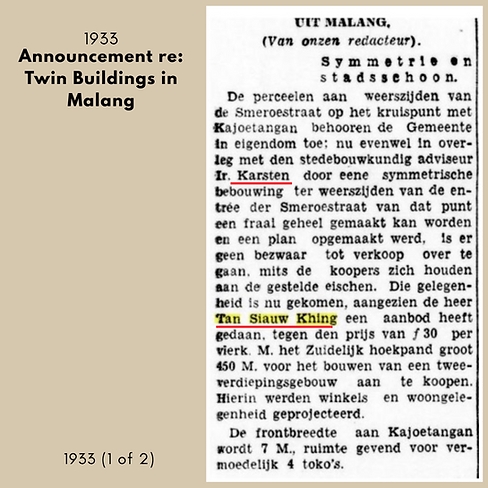
.png)
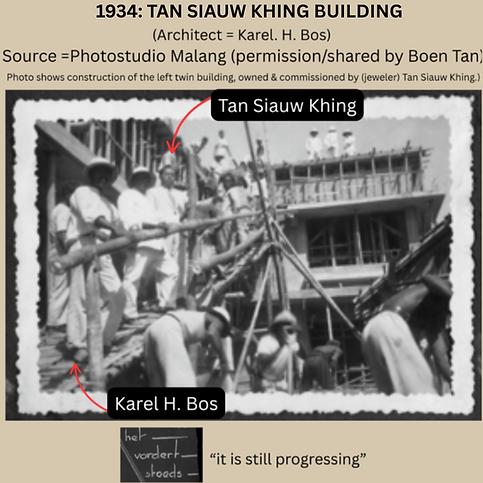.png)
Translation of above article (from Dutch):
FROM MALANG, (From our editor). Symmetry and city beauty.
The plots on either side of the Smeroestraat at the intersection with Kajoetangan belong to the Municipality: now, however, in consultation with the urban development advisor Ir. Karsten, a beautiful whole can be made by a symmetrical development on either side of the entrance to the Smeroestraat of that point. and a plan was drawn up, there is no objection to the sale, provided that the buyers adhere. to the requirements set. That opportunity has now come, since Mr. Tan Siauw Khing has made an offer to purchase the southern corner property measuring 450 M. for the construction of a two-storey building at the price of f 30 per square metre. Shops and housing were projected here. The frontage at Kajoetangan will be 7 m., giving space for probably 4 shops.
CLICK GALLERY ARROWS BELOW to scroll through construction photos
of the TAN SIAUW KHING (left) BUILDING.

Construction of TAN JEWELRY STORE

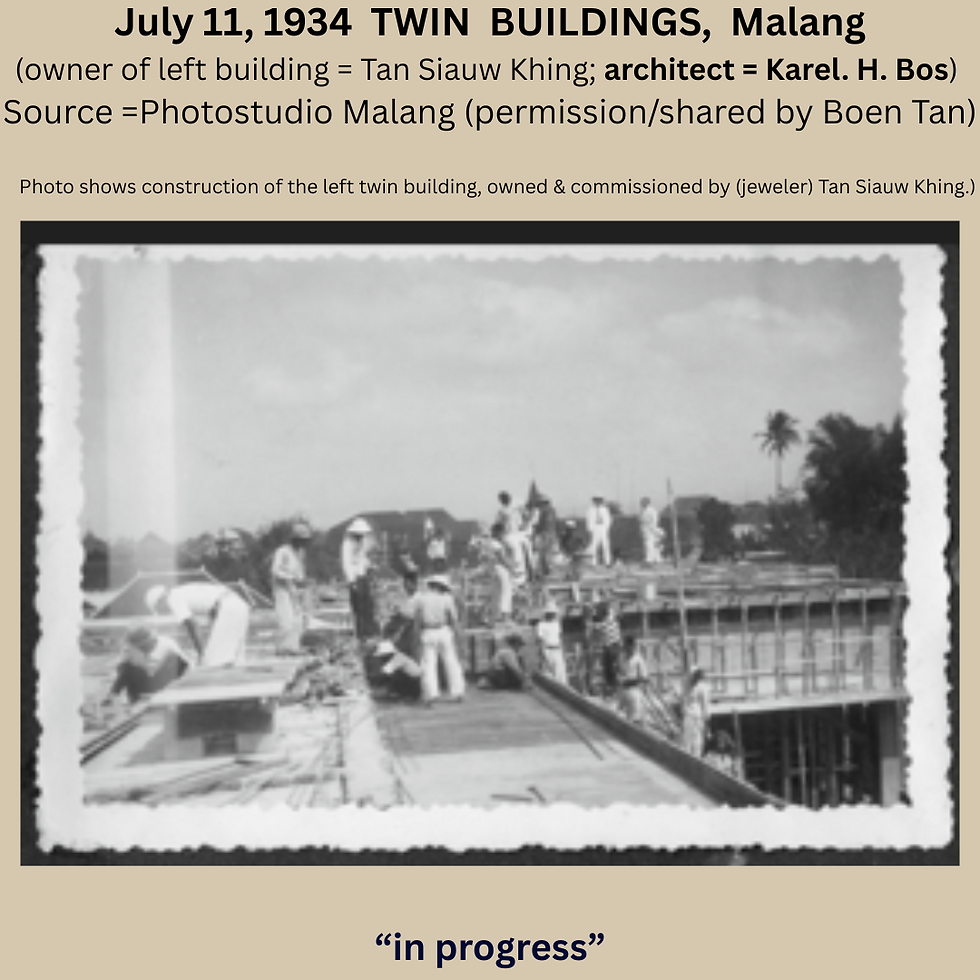

Construction of TAN JEWELRY STORE
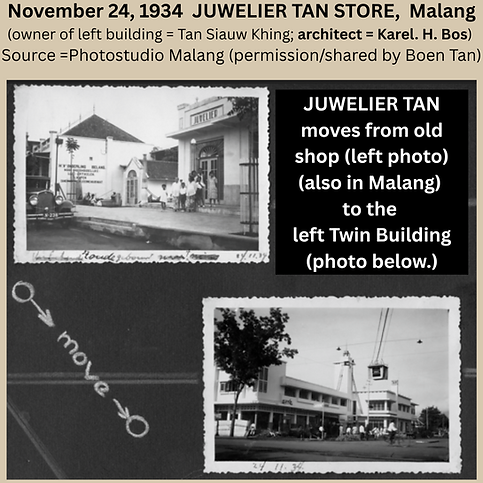.png)
.png)


.png)


Translation of above article (from Dutch):
By Juwelier Tan
The new building of Juwelier Tan, Kajoetangan corner Smeroestraal, was festively put into use on Saturday evening. The display cases and counters collapsed under the dozens of flower arrangements, which were sent by business friends and acquaintances, even from Semarang. Inside, Mr. and Mrs. Tan Slauw Khing were receiving the congratulations; the mayor came to pay his compliments in the company of Mrs. Lakeman. the patih was there, members of the boards of the local districts, the board of the Malangsche Winkeliers Vereeniging was represented by Messrs. De Ruyter, Geisterter and Weisberg. and the number of Smallholders was enormous. It was pleasant to see how especial the owners of businesses in the same sector came to congratulate their colleague on the occasion of the transfer of his business to this spacious and beautiful building. An enormous horseshoe of red roses with the words "Good luck" alerted the entrance, and behind it the flower arrangements stood in triple rows!
Later in the evening champagne foamed in the goblets and everyone came to bump into the Tan family, while some speeches were made of "sympathy and sympathy".
Upstairs, where the owner's residence is located, the neat interior design, also designed by Mr. Bos, was striking. Even a large billiard room was not forgotten.

Translation of above article (from Dutch):
MALANG.
(From our editor.)
Opening of the jeweler's shop, Tan."
Saturday evening, the opening of the new shop building of the jeweler Tan, on the corner of Kajoetangan-Smeroestraat, took place with great interest from the public.
From half past six until nine o'clock, there was a coming and going of visitors. And although Mr. Tan had also opened his house above the shop to his guests, the building was so full that we had difficulty reaching Mr. Tan and his wife to congratulate them on the new addition to the business.
If we estimate the number of visitors at 500, we believe that this is still on the low side. Mayor Lakeman, who always shows interest when it comes to Malang city life, was also present.
The number of beautiful flower arrangements, offered to Mr. Tan, amounted to many dozens. There was no more room in the shop to store the flowers. They had to be placed on the stairs, even in the house. A particularly beautiful piece was that of the Brunet family, representing a gold marquis ring, with a ruby in the middle.
With the sea of flowers that were there, Mr. Tan's building had more the appearance of a flower exhibition than a jewelry store. We must admit that on Saturday evening, with the presence of the hundred guests and so many flower arrangements, there was little to see of all the beautiful things that were displayed in the windows.
The wine of honour was generously distributed and we have a slight suspicion that Mr Tan, after the evening, must have felt that he had to "clink glasses" with his guests very, very many times. At about half past seven Mr Tan took the floor to thank his visitors for their interest. Especially now, in these times of depression, he said, among other things, the businessman needs the interest of the public. But in addition to that interest, trust is the first factor that is necessary in trade and he would always try to show himself worthy of this trust.
The speaker ended his speech with a warm word of thanks and praise to the designer and executor of the building, Mr K. Bos, of the well-known architectural firm of the same name here in Malang.
Three loud "hurrahs" responded to Mr. Tan's speech.
The attendees remained together in the most convivial manner until nine o'clock
.
Click the two links below to read more about the TAN FAMILY in an on-line article/interview.
This interview was by BOEN TAN, the grandson of Tan Siauw Khing (and my "new friend" ...YES! We actually connected, how cool is that?!!) He sent me the wealth of amazing photos that I've included on this page. His interview/article specifically mentioned my grandfather's name, which is how I initially "found" him. The article talks about the Tan family and this jewelry store.
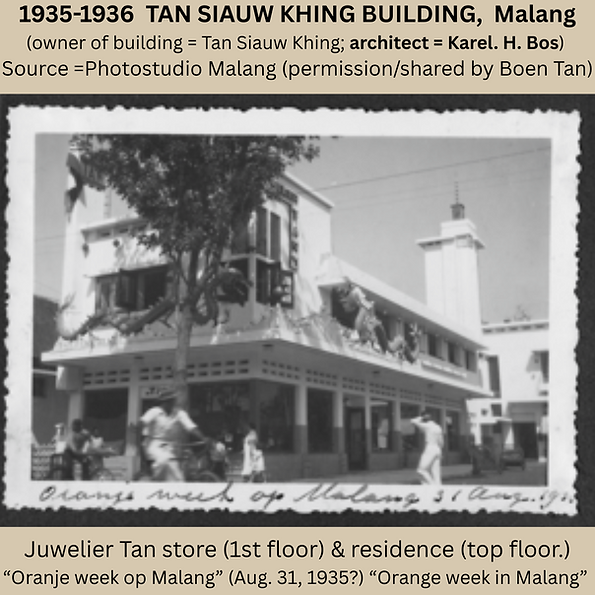.png)
.png)
.png)

CLICK GALLERY ARROWS BELOW to scroll through photos taken from the rooftop.




1935: SEMERU-KAYUTANGAN COMPLEX, MALANG
Mixed-use Complex (Shops & Homes)
Built along Jalan Semeru No.2 – No.0
The following year, in 1936, these become the Kayutangan TWIN BUILDINGS (Art‑Deco/New Indies Style) (1936) Twin cube-form buildings on the intersection of Kayutangan–Semeru–Kahuripan. Recognized in urban planning by Karsten as Malang’s gateway streetscape.
All additional info is included in the next section below, "1936: THE TWIN BUILDINGS"
1936: THE TWIN BUILDINGS (Shops & Homes Complex), MALANG
Radjabally crossroad (now Jalan Jenderal Basuki Rahmat No. 81) at the end of Jalan Semeru #2, RW.4, Oro-oro Dowo, Kec. Klojen, Kota Malang, Jawa Timur 65119
Karel Bos is most known for this famous landmark, which still stands today. These two buildings served as markers and were intended as symbolic gateways to West Malang. The buildings, characterized by their cube-shaped forms, flat roofs, and minimal decorative elements, exemplify the Nieuwe Bouwen (New Building) style, which emphasizes functionalism and minimal ornamentation, as well as climate response. This location was developed as a housing and commercial complex.
Constructed in 1936, these symmetrical shops—each crowned with a distinctive tower—were deliberately planned by Bos as architectural “hands” framing the surrounding hills. The towers were functional too: they served as local viewpoints and orientation markers in Bos’ adaptation of “Nieuwe Bouwen.”
The corner shop at Kayutangan (Semerostraat and Kayutangan intersection), and entire left-side building was commissioned by Tan Siauw Khing and designed by Karel Bos. It was built in 1934. This was his third jewelry-store location and included both storefront and residence—highly prominent in Malang’s cityscape.
Tan Siauw Khing commissioned and owned the entire building on the left side, and Han Thiau An commissioned and owned the building on the right side.
Although the two buildings originally belonged to different owners, their matching design has remained a cherished landmark.
Today’s Kajoetangan Heritage Village: The twin buildings now form part of the broader Kampoeng Heritage Kajoetangan, an officially developed heritage tourism village inaugurated in 2018. While some buildings around them have been demolished or replaced, the twin buildings remain a recognizable heritage landmark. This village preserves around 23 heritage-style structures spanning architecture from the 1870s onward, including colonial, jengki, and International styles
These TWIN BUILDINGS are an iconic landmark of Malang. They are at the Kahuripan–Semeru–Basuki Rahmat intersection. These buildings currently house the BANK COMMONWEALTH, as well as a popular cafe, LAFAYETTE COFFEE & EATERY.
(Source: ChatGPT OpenAI accessed June 2025)
.png)
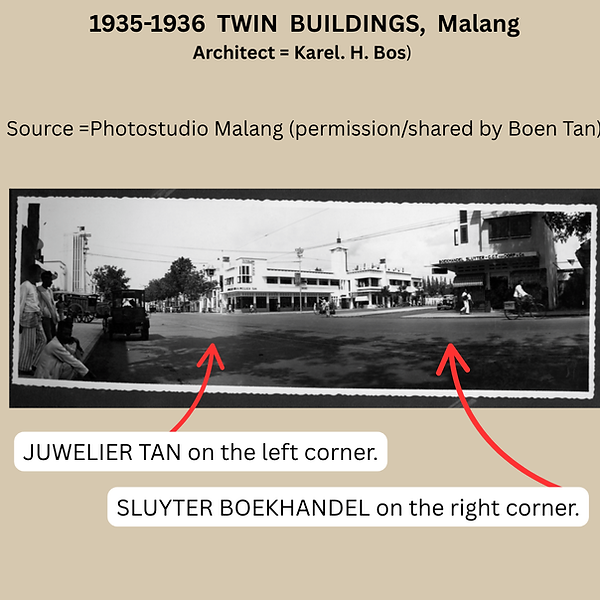.png)

CLICK GALLERY ARROWS BELOW to scroll through more historic photos of the TWIN BUILDINGS.
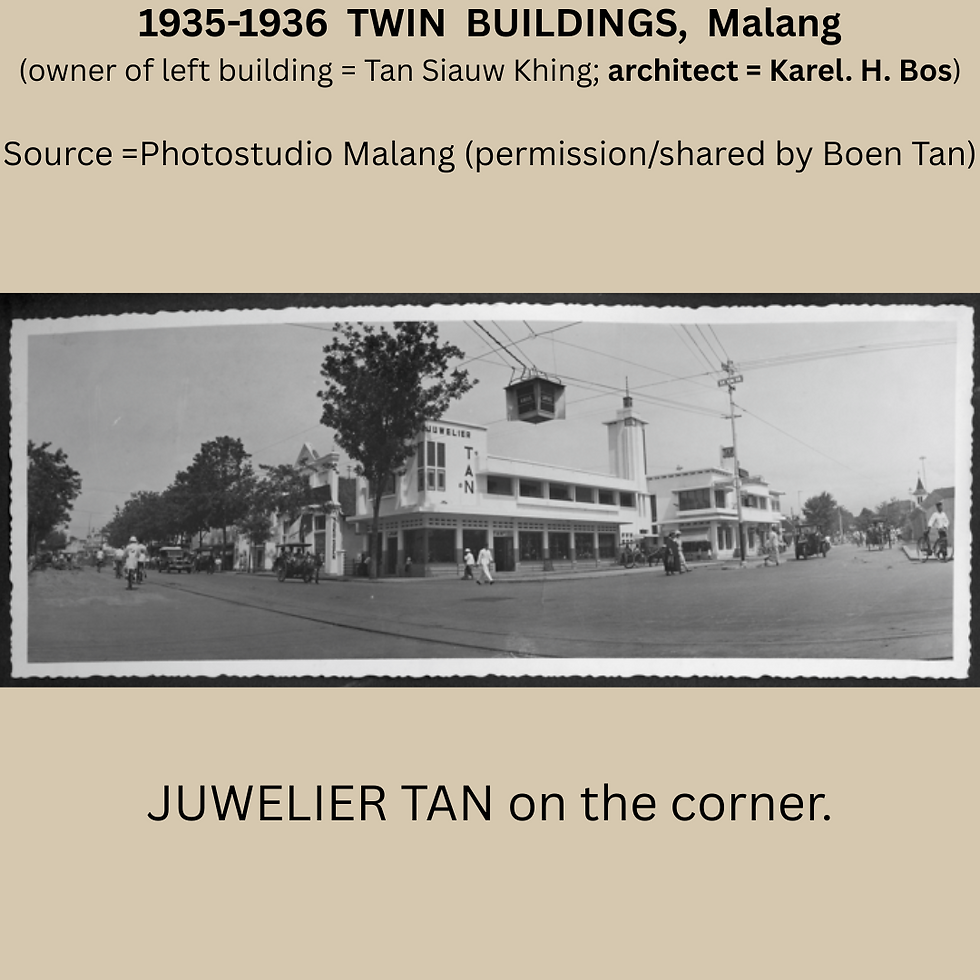
Juwelier Tan on the corner

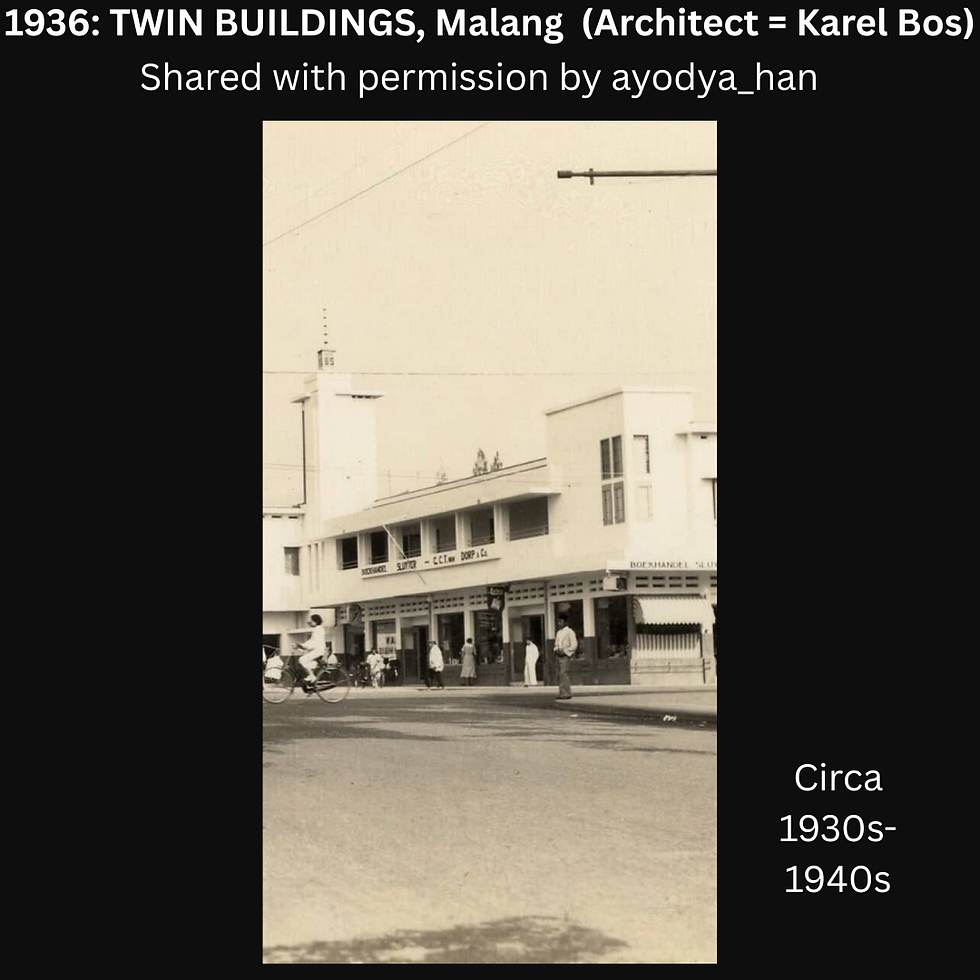

Juwelier Tan on the corner

.png)
Translation of above article (from Dutch):
Growing Malang
In Kajoetangan, Malang's main shopping district, a beautiful building will soon be built where the aforementioned street meets Smeroestraat. It will be occupied by Mr. Tan's well-known jewelry store.
The new building will undoubtedly be a jewel in our business district. The structure is being constructed by the renowned architectural firm K. Bos in Malang.
A picture of the new building as it will look when completed.

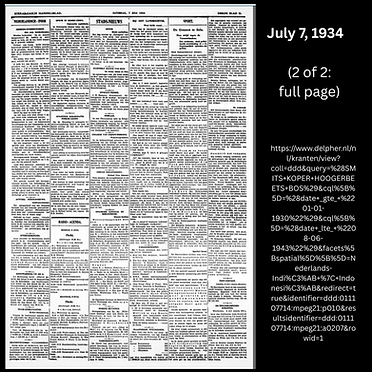


Translation of above article (from Dutch):
Malang forward!
The appearance of the cityscape in the busiest shopping street, Kajoetangan, will soon improve greatly when the row of neat-looking shop buildings, currently rising face-to-face with Studio between Bata and the military home, will be ready and occupied. One of the buildings, all of which are being built by the firm Smits, Koper and Hoogerbeets, has already been rented by Alderden's flower stores.
Furthermore, the architectural firm Bos has been working on a plot of land on the corner of Kajoetangan and Smeroestraat for some time, which will contain beautiful shop premises downstairs and which will improve the view of the crossroads considerably.


Translation of above article (from Dutch):
Postponement of the proceedings?
On Wednesday evening, the municipal council will consider the new building regulations. Now, several local contractors and architects requested the municipal council by petition to postpone this proceedings. The petition was signed by Mr. Kienecker, secretary of the
main board of the N. I. Contractors' Association, also acting on behalf of the firms Smits, Koper and Hoogerbeets, M. J. Lang and Co., Engineering bureau The, K. Bos and Tan and Oort.
The mayor and aldermen have proposed to the council to reject this request, since the new draft regulations have been available for inspection by everyone at the municipal secretariat since 11 September, so that they have had every opportunity to make any comments or remarks known.

Translation of above article (from Dutch):
MALANG.
(From our editor.)
An improvement.
One of the most important traffic points of Malang, the intersection Kajoetangan-Smeroestraat, has recently undergone a considerable improvement and will soon be improved even more effectively.
We already mentioned in passing that on the southwest corner of this intersection, the jeweler Tan had a beautiful shop building erected, which has become an ornament of our shopping district.
It was Mr. K. Bos of the architectural firm of the same name, who designed this building and who also carried out the work. Mr. Bos had only a site width of 7 m. at his disposal, but he found such a happy solution for the building that it now seems as if he had a site of twice the size available for development.
In addition to the broad aspect, Mr. Bos has sought the solution to the problem of building in height.
He has applied storey construction with a flat concrete roof, on which, when times improve, a roof garden will be installed.
By carrying out this work, Mr. Bos has also proven that the fear that flat concrete roofs would be too warm and would lead to leaks is unfounded.
On the building is a main tower of 17 m. height, in which a clock will be placed and 2. light towers, each of 14 m. height.
Not only did the construction of the southwesternmost part of the intersection Kajoetangan-Smeroestraat give this part of the city a more beautiful appearance, but the bridge located near that point was widened and the sidewalk will be extended to the Ardjoenostraat
Another Chinese resident already bought the northwestern part of the plot, located at the intersection Kajoetangan Smeroestraat.
Here too, the old, primitive buildings of a few decades ago will be demolished and a worthy pendant of the jewelry store of Mr. Tan will be erected.
The most important improvement that will be made at the intersection of Kajoetangan Smeroestraat is, however, the development of the south-eastern point, where the shops of tailor Funneman, hairdresser Van Vliet, etc. are currently located.
This point, which is currently almost half a metre lower than the Kajoetanganweg, considerably deconstructs our shopping area. Here too, the construction up to the pavement will be a considerable improvement.
As we understand it, the construction of both points will be done by the architect K. Bos, who knew how to design such a beautiful shop for the jeweler Tan.
We would call this a happy feeling, because then there will undoubtedly be unity in the construction, which can only be in the interest of the city's beauty.
Among all those modern shops on Kajoetangan, there are still, as remnants of the past, the really old-fashioned houses, occupied by the military home and Toko Aaaaak.
When will new shops also be built on these premises?
Renovation Mutual Interest.
A few months ago we reported that the management of N. V. Onder 11ng Belang had decided to give its shop on Kajoetangan a significant extension. The warehouses behind the building were demolished and the existing anteroom was extended at the rear.
As a result, Onderling Belang has acquired a hall of over 400 m², as far as we know the largest shop space here in Malang.
The spacious warehouses are located under the newly built section.
The renovation is now as good as complete. We heard that the new extension will soon be put into use, which will be done in a somewhat festive manner.
We were also informed that Onderling Belang will commemorate the fact that the business opened its doors thirty years ago in the first half of next year. opened in Malang.
This event will not go unnoticed by the N. V. As a special feature, we can mention that Onderling Belang has remained at the same location during these three decades.
%20December%207%201934%20Tan%20Bos.png)

Translation of above article (from Dutch):
“Malang's beautification."
Indeed, that is the case when we now drive or walk over Kajoetangan. On the Smeroestraat and Kajoetangan a magnificent building has been built, where the well-known jeweler Tan has established his business. The architect and executor K. Bos is proud of his work.
The dingy corner with its many warongs and the like has made way for a beautiful city district.
Plans exist to place a similar building on the other corner; we would almost say, it couldn't be better.
(Note: This article shows that “Jeweler Tan” was the first shop built of what would soon become the TWIN BUILDINGS.)


Translation of above article (from Dutch):
The beautification of Kajoetangan.
Monday morning, the renovation of the shops on the South-East, corner of the Kajoetangan Smeroestraat crossroads will begin, where the shops of the tailor Funneman and the hairdresser Van Vliet are.
This work was also entrusted to the architectural firm K. Bos, which firm also designed the beautiful shop building of the jeweler Tan.
When this work is completed, the north-western corner of the Kajoetangan Smeroestraat intersection will be next, where a shop building will be erected, which will be a worthy "pendant" of that of Mr. Tan.
The projects for this were also prepared by the architectural firm K. Bos. These constructions and the widening of the Smeroestraat at this point have created a magnificent entrance to the Bergenbuurt.
TAN JEWELRY STORE AD: A Thing of beauty is a joy forever. You will never be so convinced of this as when you visit Jeweler Tan.
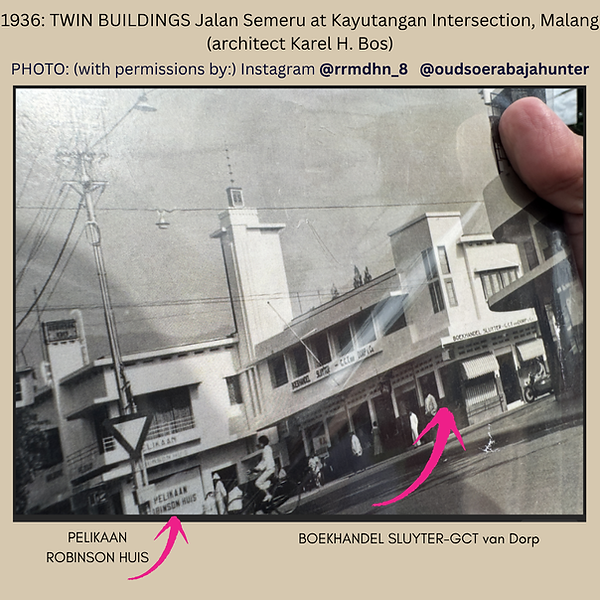.png)
The Pelikaan Robinson Huis
(pictured above)
in colonial-era Malang, East Java, Malang was a shoe store. There was already at least one other location at the time of the opening of the Twin Buildings. (Pelikaan = Dutch for “Pelican.” and was commonly used in the names of colonial businesses.)
(source = ChatGPT OpenAI accessed July 2025)
See newspaper ads below.
Boekhandel Sluyter (pictured above) was a prominent Dutch-owned bookstore and publisher during the colonial era in Malang, East Java, Indonesia. It operated during the late 19th and early 20th centuries, a period when Malang was a flourishing colonial city with a significant European population and a growing cultural and intellectual scene.
Boekhandel Sluyter functioned primarily as a bookseller (boekhandel) and stationer (kantoorboekhandel), providing Dutch-language books, periodicals, newspapers, maps, and writing materials. It catered mainly to the Dutch colonial community, educators, and government officials.
It likely served as an informal cultural hub, where intellectuals, teachers, and colonial administrators could access literature, textbooks, and perhaps even political or philosophical works from the Netherlands. It would have played a role in educational life, especially since Dutch-language instruction was central to colonial schooling.
Like many such institutions, Boekhandel Sluyter reflects the Dutch attempt to replicate European cultural life in the Indies. After Indonesian independence in 1945, many Dutch businesses, including bookstores like this one, either closed down, were nationalized, or were taken over by Indonesian owners. (source = ChatGPT OpenAI accessed July 2025) See newspaper ads below.
.png)

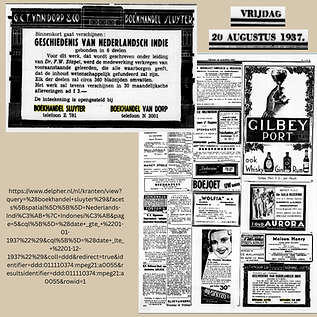


1950s-1960s TWIN BUILDINGS

.png)
(Per ChatGPT OpenAI accessed August 2025): This (above, right) photo is likely from the 1965-1966 Anti-Communist Purge.
Both of the above photos show RADJABALLI & SONS (Foreign Money-Changing business.) From the 1930s to 1940s, this corner shop was the BOEKHANDEL SLUYTER (book store.)
The shop “Radjaballi & Sons” (also spelled Radjab Alli & Sons) in Malang was a foreign exchange / money‑changing business founded in the era of Dutch colonial rule. It gave its name to what became known as Perempatan Rajabally (Rajaballi Intersection), where a pair of iconic twin‑style modernist buildings stood. One of those was located at the northwest corner of the intersection and housed the Radjaballi exchange shop from the 1950s onward.
Radjaballi & Sons, an India‑Pakistani family business, operated a foreign currency exchange service in that corner building from the mid‑20th century; over time the name came to identify the intersection itself.
PRESENT DAY TWIN BUILDINGS
.png)
.png)
CLICK ON GALLERY ARROWS BELOW to scroll through more modern photos of the Twin Buildings.

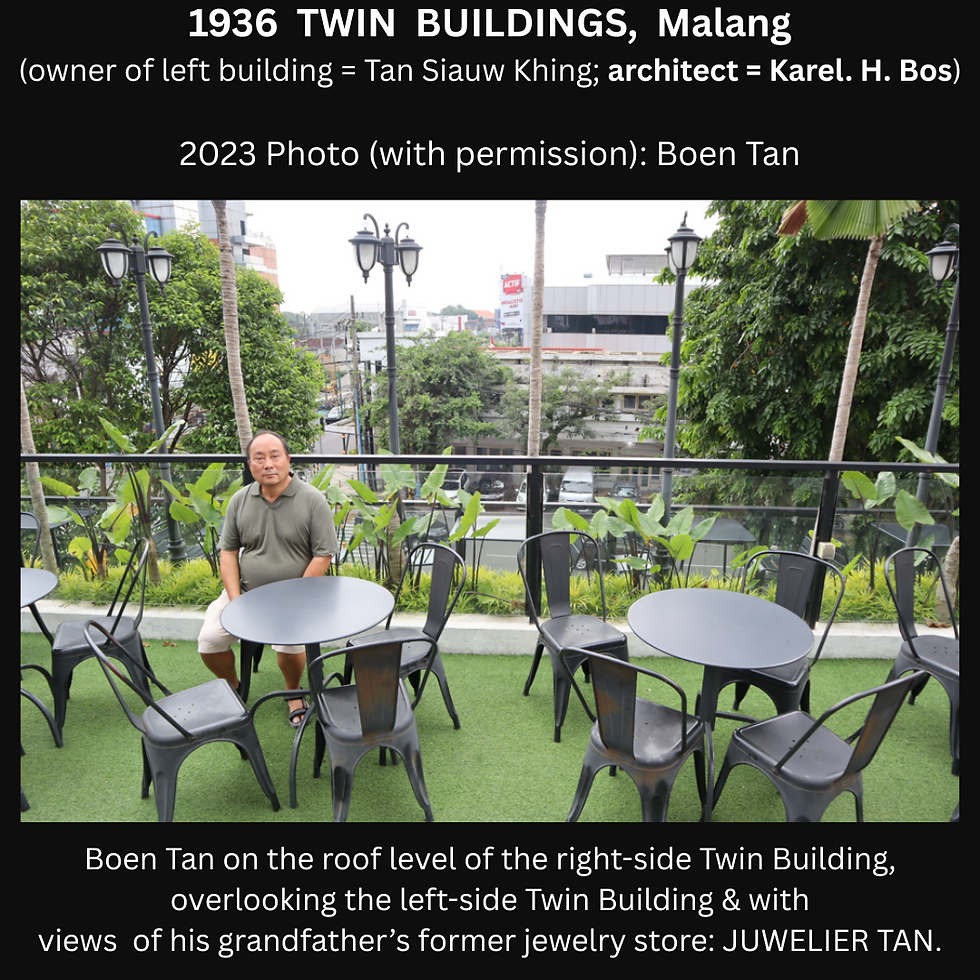
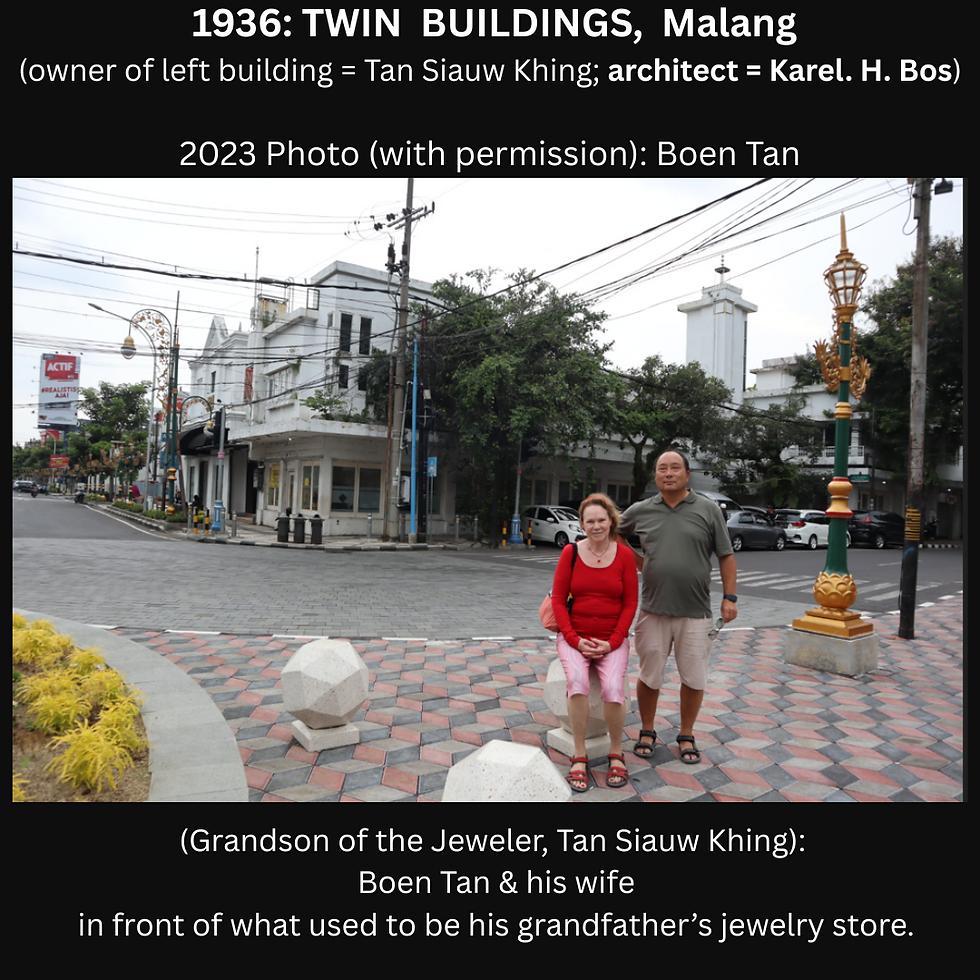

Check out this YOUTUBE video that features the Twin Buildings, specifically the right-hand building before the 2021 renovations.
The host actually says the name of KAREL BOS at about 2:09!
Check out this YOUTUBE video. It is also all about the Twin Buildings, specifically the right-hand building. It shows the INTERIOR, EXTERIOR, & ROOFTOP, just before the 2021 renovations for the opening of Lafayette Coffee & Eatery.
It also shows the name of KAREL BOS on the screen at 1:05!
Check out the YouTube videos below to see the beautiful right-side building of the TWIN BUILDINGS, which now houses the LAFAYETTE COFFEE & EATERY
Check out the YouTube video below to see the KAJOETANGAN/KAYUTANGAN HERITAGE VILLAGE.
1938: REX CINEMA, MALANG
Located at Alun-alun (central square) of Malang
The Rex Cinema (originally Rex Theater/Bioskop) was a was a majestic Art Deco venue, and cultural and architectural landmark of colonial Malang.
Designed by the esteemed architect Karel H. Bos, it was constructed in mid‑1938. The theater cost about 35,000 guilden, built in just six months by contractor B. G. Tan from Surabaya. It was located on the east side of Malang’s Alun‑alun (now Jalan Merdeka Timur), adjacent to the regent’s office, with a distinctive tower and rich decorations. Its lavish Art Deco façade, neon lighting, metal ornamentation, marble floors, and large portraits (e.g., Queen Wilhelmina’s) reflected its high social standing.
It opened with great fanfare on a Saturday morning at 10 a.m in 1939, and became a beloved entertainment venue. The opening was attended by notable figures, including:
-
F. Young, director of the Malang Bioscoopbedrijf (Cinema Company)
-
Han Soen Lok, general manager
-
B. G. Tan director of the Bouwkundig- en Aannemersbureau Tan (Architectural and Contracting Bureau Tan)
-
City officials, including aldermen March, Van Helsdingen, and Kho Sien Tjo
-
Military officers, such as Lt. Colonel Scholten and Lt. Colonel Fikenscher
-
Representatives from various agencies like Aniem (electric company)
-
police inspectors, civic leaders, military officials, clergy, stock brokers, ex-VOC members, and other prominent local figures
In 1947, during the first Dutch military aggression, the Rex-Theater was intentionally burned by Indonesian fighters to prevent reuse by colonial forces. Despite suffering war-time damage in 1947, it was rebuilt and continued to thrive. It was fully renovated in 1949–50, restoring its original Art Deco style.
Rebranded as Bioskop Ria in the 1970s, following national policies shaping post-independence identity.
The Rex Theater maintained popularity through the mid‑20th century. However, by the 1990s, amid the rise of cineplexes, it closed and was demolished. Today, the site serves as a bank branch, previously Lippo, now CIMB NiagaIn. Its memory lives on through local heritage and the distinctive Art Deco style that once graced Malang’s central square.
(Source: ChatGPT OpenAI Accessed June/July 2025)


Photo to left =
This rare interior photo, labeled “Rex theatre before the fire”, showing the seating layout and stage area—
an invaluable glimpse at the Art Deco interior design that Karel H. Bos envisioned.
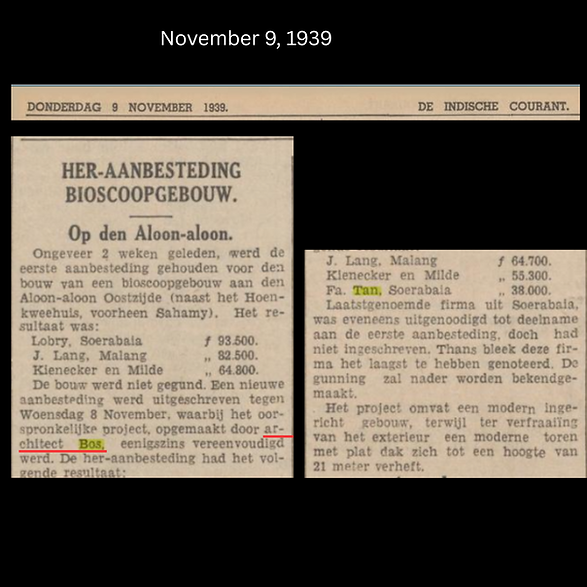.png)
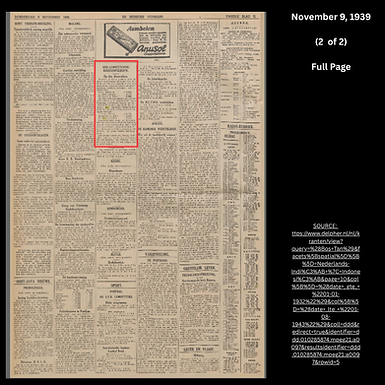
Translation of above article (from Dutch):
RE-TENDER CINEMA BUILDING.
On the Aloon-aloon.
About 2 weeks ago, the first tender was held for the construction of a cinema building on the Aloon-aloon East side (next to the Hoenkweehuis, formerly Sahamy).
The result was:
Lobry, Soerabala f 93,500.
J. Lang, Malang 82,500.
Kienecker and Milde 64,800.
The construction was not awarded. A new tender was issued for Wednesday 8 November, whereby the original project, drawn up by architect Bos, was somewhat simplified.
The re-tendering had the following result:
J. Lang, Malang f 64,700.
Klenecker en Milde 55,300.
Fa. Tan, Soerabaia 38,000.
The latter firm from Soerabaia, had also been invited to participate in the first tender, but had not submitted. It now turned out that this firm had the lowest bid. The award will be announced later. The project includes a modernly furnished building, while to embellish the exterior a modern tower with a flat roof rises to a height of Ep 21 meters.
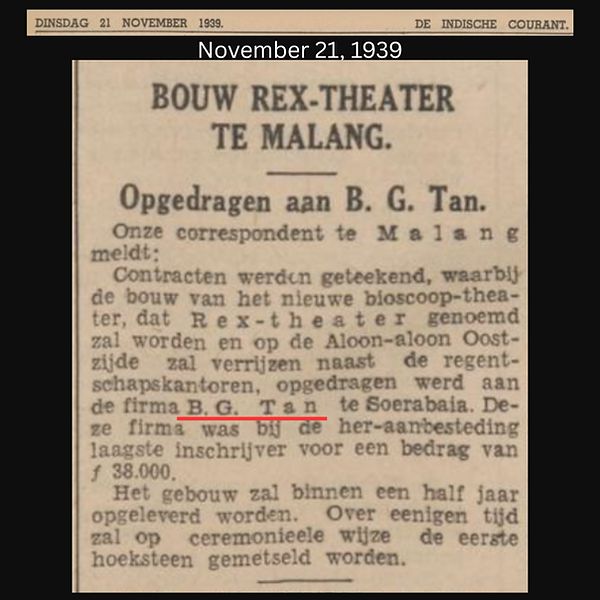
.png)
Translation of above article (from Dutch):
CONSTRUCTION OF REX THEATRE IN MALANG.
Dedicated to B. G. Tan.
Our correspondent in Malang reports:
Contracts were signed, whereby the construction of the new cinema-theatre, which will be called Rex-theatre and will be built on the Aloon-aloon Oost-zijde next to the regency offices, was assigned to the firm B. G. Tan in Surabaya. This firm was the lowest bidder at the re-tendering for an amount of f38,000.
The building will be delivered within six months. In some time, the first cornerstone will be ceremonially laid.
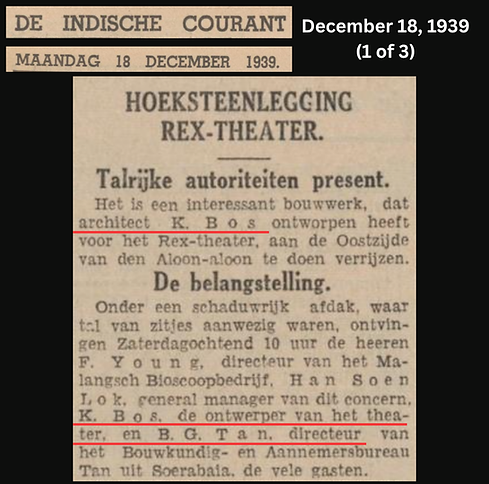
.png)

Translation of above article (from Dutch):
CORNERSTONE LAYING
REX THEATRE.
Numerous authorities present.
It is an interesting structure, designed by architect K. Bos for the Rex Theatre, to be built on the east side of the Aloon-aloon.
The interest.
Under a shady canopy, where numerous seats were available, Messrs. F. Young, director of the Malang Cinema Company, Han Soen Lok, general manager of this company, K. Bos, the designer of the theatre, and B. G. Tan, director of the Tan Construction and Contractors Bureau from Surabaya, received the many guests on Saturday morning at 10:00 a.m. Messrs. F. Young, director of the Malang Cinema Company, Han Soen Lok, general manager of this company,
K. Bos, the theater's designer, and B. G. Tan, director of the Construction and Contractors Bureau Tan from Surabaya, the many guests.
The municipal council was represented by aldermen March, Van Helsdingen, and Kho Sien Tjo, while director G.W. De Haan was also present. The acting commander of the 6th Infantry Regiment, Lieutenant Colonel Scholten, and the local military commander, Lieutenant Colonel Fikenscher, most of them accompanied by their wives, were also present.
Also present were Messrs. De Vries, agent der Aniem, and Fischer, chief inspector of police.
Nearby were the entire indigenous personnel involved in the construction.
Mr. Bos gave an introductory speech, thanking them for so many people coming and expressing the hope that the official opening of the theater would receive the same level of interest.
Afterwards, the director's daughter, the lovely Mayling Young, was named after the husband a note from China's stalwart Marshal Chiang Kai-shek—led to the front wall to lay the cornerstone, with Mrs. Young assisting.
The wine of honor par excellence, champagne, filled the goblets, and a toast was raised to the successful construction of the Rex Theater!
Then the workers approached, soon seated around a slametan. The penghoeloe recited a prayer and a blessing, after which all honors were paid to the slametan.
The management's guests spent a considerable time in this hospitable setting, while beautiful souvenirs were presented as a reminder of the ceremony.
It should also be noted that the official opening performance can be expected in May 1940. Mr. Young promised that all proceeds from the first performance in the new building would be donated to the Malang branch of the S.C.V.T. A beautiful thought indeed!
The wide, double entrance to the theater's hall is flanked by shop windows. The theater seats 700 people, while the upstairs auditorium can accommodate 200.
The future purpose of this auditorium is not yet entirely certain.


Translation of above article (from Dutch):
THE REX THEATRE.
On Saturday morning, the foundation stone of Malang's most ultra-modern cinema, the Rex Theatre, was laid in the presence of a large audience.
On behalf of the municipal authorities, the following were present:
Mr. Van Helsdingen, Kho Sien Tjo, March, and also Major Scholten, Major Fikenscher, Mr. De Haan, director municipal employee, Mr. Vries, agent of the Aniem, the designer Mr. K. Bos, the contractor Mr. Tan, and many others, most of them with their ladies.
Mr. and Mrs. Fred Young received the guests in their own gracious the: little young daughter, May Ling, performed the ceremony of laying the stone. The unaccustomed toddler helped by la chère Maman, after which the cerewine (champagne) flowed in a gentle stream.
The princely building, that will be flanked on both sides by modern shops, among other things a recial premises for the hairdressing salon, "star" is being furnished, has a hall, calculated for more than 700 people, a stage for orchestra, and upstairs the "cercle", with bar and dancing.
We also heard that the entire receipts of the opening night will be donated to the S.C. V.T., a gesture that will be extremely appreciated.

Translation of above caption (from Indonesian):
1. On August 7, this new theater was opened in Malang by Burgemeester J. H. Boerstra. This theater belonged to Njoo Tiong Gie, who frequently donated to the Chinese and Ned Charity Red Cross Funds.

Above newspaper photo: (Was unable to translate?) The mayor at the grand opening of the Rex Theatre.

CLICK GALLERY ARROWS BELOW to see what movies were playing!
This "slide show" is as much for fun as it is for historical reference. Enjoy.
(The source for all newspaper “clippings” on tis page is https://delpher.nl/)




When I see these, I love to imagine my grandfather watching movies with his family and friends at the theater he designed. I wonder what type of movies he enjoyed, and which movies he saw here…
Late 1930s? SHOPPING & RESIDENTAIL COMPLEX, MALANG
Jalan Jenderal Basuki Rahmat No. 100, Malang
I have not been able to confirm this building (especially with the street name and address changes.) However, it did appear in several searches so I am including it. There is e a resemblance to the Twin Buildings design style.
1941: ATRIUM THEATER (Renovation), MALANG


.png)
Translation of above article (from Dutch):
RENOVATION OF THE ATRIUM THEATER.
A start will soon be made on the renovation of the Atrium theatre, in order to bring it to a level that a first-class theatre should be. The number of seats will remain unchanged, but the entire entourage will be improved, raised the same
For example, the lobby will be brought to the level that will reach the height of the cinema hall. are demolished and new walls built so that the hall width is increased; the entrances to the ranks will therefore gain in width. The two side walls will be used as the entrance
The management of the Malangsch Cinema group charged architect Bos with the drawing up of project.

